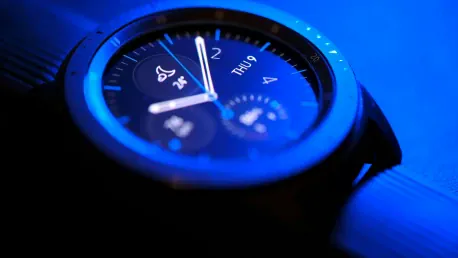The wearable technology landscape is on the brink of a significant transformation. As we look forward to 2025, the advancements and trends in this sector promise to redefine how we interact with technology on a daily basis. Reflecting on the progress made in 2024, we can see the foundation being laid for even more groundbreaking innovations. This article delves into the major predictions for wearable tech in 2025, offering a glimpse into the future of this dynamic industry.
The Rise of Samsung Galaxy AR Glasses
In 2025, Samsung is expected to make a bold entry into the augmented reality (AR) market with the launch of its Galaxy AR glasses. These glasses are anticipated to be sleek and stylish, drawing design inspiration from Meta’s Ray-Ban AR glasses. Engineered for everyday wear, they are set to integrate seamlessly with the Galaxy ecosystem, including Samsung’s top smartphones and the Galaxy Ring. This integration promises a cohesive experience, enabling users to switch between devices fluidly without missing a beat.
The Galaxy AR glasses are rumored to feature AI-driven functionalities and gesture controls, enhancing user interaction. Additionally, there is speculation about a payment feature compatible with Google Pay, making these glasses not just a tech accessory but a practical tool for daily use. Operating on Samsung’s Extended Reality (XR) platform, these glasses are poised to offer a new level of connectivity and convenience. These advancements reflect Samsung’s ongoing commitment to pushing the boundaries of what’s possible with wearable technology, blending practical utility with cutting-edge tech.
Anticipation for Apple Watch Ultra 3 and SE 3
Apple’s wearable tech lineup is also set for exciting updates in 2025, with the anticipated release of the Apple Watch Ultra 3 and SE 3. The Ultra 3 is expected to introduce advanced AI features, potentially through Apple Intelligence, which will enhance the user experience with more personalized and intelligent interactions. These features could set a new standard for smartwatches, positioning the Ultra 3 as a must-have device for tech enthusiasts and casual users alike.
The SE 3, on the other hand, might see a switch from metal to plastic for its case material, reducing both cost and weight. This change could make the SE 3 more accessible to a broader audience, with a competitive price point of $149. Additionally, there may be a larger case size option, catering to different user preferences. These updates reflect Apple’s commitment to innovation and user-centric design. Apple’s approach highlights their strategic focus on balancing affordability with advanced features, ensuring their wearables remain competitive and appealing to a wide range of consumers.
Innovations in Apple Watch Series 11
Continuing its tradition of annual updates, Apple is set to release the Apple Watch Series 11 in 2025. This model is predicted to feature advanced capabilities powered by Apple Intelligence, offering users a more refined and efficient experience. Enhancements in AI will further personalize user interactions, making the device smarter and more responsive to individual needs. It’s an evolution that aims to elevate the user experience to unprecedented levels of sophistication and ease.
One of the significant anticipated changes in the Apple Watch Series 11 is the incorporation of MicroLED technology. MicroLED technology promises to address the longstanding battery life constraints of the Apple Watch. Unlike the current OLED screens, MicroLED is more power-efficient and offers improvements in brightness, resolution, saturation, and color accuracy. Additionally, there are reports hinting at the possibility of incorporating blood pressure and blood-glucose monitoring capabilities, although these features might not be ready for immediate release. These innovations denote a leap forward in wearable technology, potentially setting new benchmarks for performance and utility in the industry.
Samsung Galaxy Ring 2: Building on Success
Following the successful debut of Samsung’s first smart ring in January 2024, the Galaxy Ring 2 is expected to continue the momentum into 2025. Leaks suggest that the new iteration will feature a thinner and lighter design with enhanced battery life and additional functionalities. Such improvements are aimed at making the device more comfortable and convenient for everyday use, thereby broadening its appeal among a diverse user base.
While specific details remain scant, there is speculation that Samsung might preview the Galaxy Ring 2 during the January launch event for the Samsung S25 smartphone. This preview could generate significant buzz, although the product might not be available for purchase immediately. The Galaxy Ring 2 is poised to build on the success of its predecessor, offering users a more refined and capable wearable device. This progression underscores Samsung’s dedication to both innovation and user-centric design, ensuring their products remain at the forefront of the wearable tech market.
The Future of Fitbit: No New Models
Under Google’s stewardship, the Fitbit brand saw significant changes in 2024, including the discontinuation of the Fitbit Sense and Versa smartwatch lines. This trend is expected to continue in 2025, with no new Fitbit models like the Inspire 4 or Charge 7 anticipated for release. The strategic decision reflects a shift in focus, potentially allowing Google to streamline its wearables division and concentrate on integrating Fitbit technologies within its broader ecosystem.
Currently, only the entry-level Fitbit Inspire 3, mid-range Fitbit Charge 6, and the kid-centric Fitbit Ace LTE remain in the product lineup. The end of the Inspire and Charge lines suggests a strategic realignment by Google, possibly focusing on other technological innovations or integrations. This shift indicates a more streamlined approach to Fitbit’s product offerings. The changes hint at a future where Fitbit technology could be more seamlessly embedded into other Google products, offering users a more integrated and cohesive experience.
Integration and Ecosystem Synergy
A recurring theme in the wearable tech industry is the increasing interconnectedness and integration of devices within broader tech ecosystems. Both Samsung and Apple are projected to enhance the compatibility and synergy of their wearables with other devices, ensuring seamless user experiences. This move towards integration reflects a broader industry trend aimed at providing users with a more unified and intuitive tech environment.
This trend towards integration is driven by the desire to create a cohesive and intuitive user experience. By ensuring that wearable devices work seamlessly with smartphones, tablets, and other tech products, companies can offer a more compelling and convenient proposition to consumers. This focus on ecosystem synergy is likely to be a key driver of innovation in 2025. The anticipated enhancements in integration are set to streamline everyday tasks and interactions, making technology an even more intrinsic part of daily life.
Advances in AI and Health Monitoring
The landscape of wearable technology is nearing a pivotal transformation. As we anticipate the advancements and innovations poised for 2025, it becomes clear that this sector is set to reshape our day-to-day interactions with technology. Reflecting on the strides made in 2024, it’s evident that these developments have laid the groundwork for even more revolutionary breakthroughs. This article explores the significant predictions for wearable tech in 2025, offering a detailed look into the future of this rapidly evolving industry. From smarter health monitoring devices to more integrated and personalized user experiences, the potential for wearables in the coming year is vast. The improvements in battery life, seamless connectivity, and AI integration will likely enhance functionalities and make these devices indispensable tools in our lives. As we stand on the cusp of these advancements, the future of wearable technology appears not only promising but transformative, signaling a new era in how we engage with and benefit from technology every single day.









